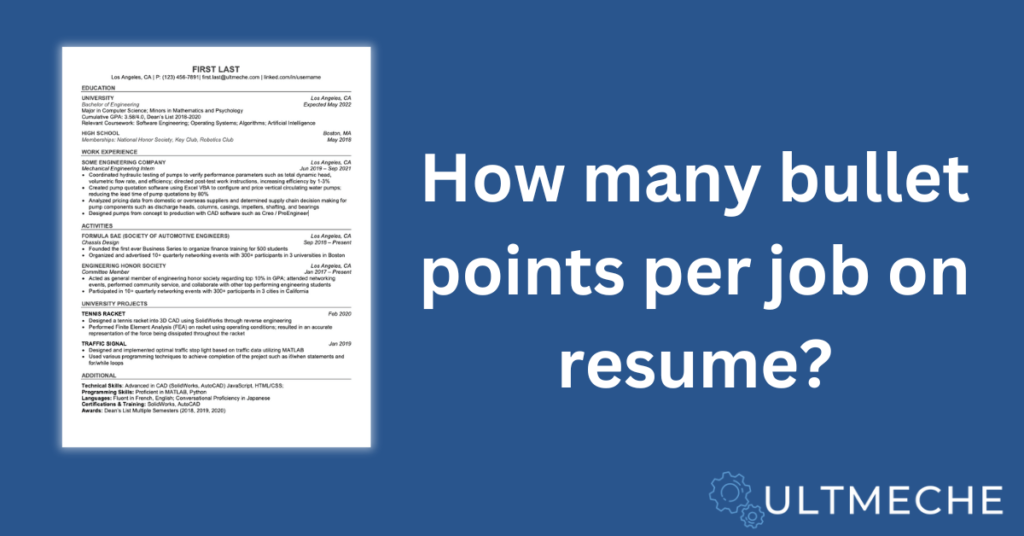When it comes to crafting a resume every word holds significance. Each detail contributes to shaping your story. One common question that arises is how many bullet points should be included for each job experience. This decision greatly affects the readability and effectiveness of your resume. Striking the balance, between being concise and providing information is crucial in capturing the attention of potential employers. In this guide we will delve into this aspect of resume writing guiding you towards making informed choices that will help you create an outstanding resume. Lets work on improving your job search journey together.
March 2, 2024
Why Bullet Points Matter on a Resume
An impactful resume showcases your experience, skills and achievements. Utilizing bullet points for each position listed on your resume helps communicate this information concisely to employers. Bullet points bring attention to details. Facilitate quick reading of the information provided. They enable you to emphasize aspects of each role in a scannable format. A good rule of thumb is to include three to five bullet points for each position offering detail without overwhelming the reader. Focus on highlighting accomplishments and tangible contributions.
By following these recommended practices for utilizing bullet points in your resume you can create a case, for your candidacy and increase your chances of securing an interview.
It will definitely be worth the effort!
Keep reading to learn how many bullet points per job on resume for your job search!
The Ideal Number of Bullet Points Per Job
When determining how many bullet points to include for each position on your resume, there are a few factors to consider:
Experience and Responsibilities
When listing positions where you held responsibility or had years of experience aim to include 3 to 5 bullet points that effectively portray the scope and impact of your role. Give an overview of your responsibilities and quantify any notable achievements or results whenever possible.
Less Experienced Roles
For positions held earlier in your career or, for a duration 2 to 3 bullet points should suffice. Emphasize skills and highlight any major accomplishments. Keep the descriptions concise while still conveying the value you brought to that role.
Consistency and Flow
As a guideline try to maintain a number of bullet points for each position on your resume. This creates a layout. Helps the reader easily follow your career progression. However feel free to make adjustments based on the roles in order to emphasize experience and match the level of responsibility required. Ultimately focus on maintaining a flow and impact that effectively showcases your qualifications.
Relevance to Target Role
The number of bullet points for each position also depends on its relevance to your target role. Provide details for experiences directly related to what you’re pursuing next. You can be more concise when describing positions that’re still important, in shaping your career narrative but not as closely connected with your future goals. Focus on how your background will contribute to your success.
To determine the number of bullet points, for each position on your resume consider factors such as your level of experience, job responsibilities how consistent your resume is and how relevant each point is to your career goals. It’s important to prioritize quality over quantity in order to make an impression. Your resume should effectively showcase the progression of your career. Emphasize why you are the candidate, for the job.
Crafting Strong, Impactful Bullet Points
When creating bullet points for your resume, it’s important to craft them carefully to maximize their impact.
Focus on Relevant Accomplishments
Bullet points should highlight your relevant accomplishments and key wins in each role, not just list routine job duties. Ask yourself, “What key achievements or contributions did I make in this position?” Then, quantify and qualify them.
For example
Reduced customer complaints by 25% year over year through improved quality assurance processes. Launched social media marketing campaign that increased web traffic by 50% and online sales by 40%.
Use Powerful and Persuasive Language
Choose active verbs and words that convey the scope and influence of your work. Some examples include: transformed, optimized, pioneered, envisioned, accelerated, etc.
For example:
Pioneered use of data analytics to optimize marketing spend, increasing ROI by 35%.
Transformed outdated processes using automation and AI to improve efficiency by 50% and reduce costs by 40%.
Quantify and Qualify Impact
Use hard numbers and metrics to demonstrate the scale of your impact in a concrete, quantifiable manner. Percentages (%), dollars ($), numbers (#), and statistics are persuasive ways to convey your influence.
To learn how many bullet points per job on resume, let’s check out a specific example of implementation of our quantifying framework.
For example:
By enhancing the quality of customer service and implementing strategies to retain clients we managed to reduce customer attrition by 30%. Moreover with a executed marketing approach the sales of our new product line increased by $500K during the first half of this year. These valuable tips will help you create bullet points that’re not concise but also captivating to potential employers. Make sure to highlight your achievements and the significant impact you have made using language and concrete numbers to demonstrate your influence and accomplishments.
Customizing Bullet Points for Different Jobs
To make your resume stand out for each job position it’s important to tailor the bullet points in a way that highlights the requirements and your relevant experience. The number of bullet points should be based on how impactful and relevant your work was, in that role.
Tailor Bullet Points to the Job
To determine the number of bullet points for each position carefully analyze the job listing and identify the qualifications and responsibilities. Then assess your experience in that role. Select noteworthy accomplishments that align with what the hiring company is seeking.
For instance, if you’re applying for a project manager position where strong communication skills are are essential emphasize bullet points such as;
Conducted daily stand up meetings and provided weekly status reports to keep executive stakeholders and cross functional teams updated on progress.
For a job requiring budget oversight
In addition effectively managed an operating budget of $2.5M by implementing spend management techniques and renegotiating vendor contracts resulting in a 15% reduction in costs year after year. Accurately forecasted, tracked and reported on project budgets to ensure adherence to approved targets.
Including details measurable metrics and quantifiable impacts, within your bullet points will demonstrate to employers that you have what it takes to excel in that particular position.
To create a resume make sure to highlight your relevant achievements at the beginning of each section. If you’re discussing roles that are not directly aligned with your career goals focus on including two to three high level bullet points. Emphasize the positions that best demonstrate why you are a candidate, for the job.
Conclusion
Your resume serves as your introduction to employers and plays a crucial role in determining whether you get an interview or not. Crafting a resume involves presenting concise impactful bullet points. Aim for 3 to 5 bullet points, per role highlighting your accomplishments and the value you brought to the organization. Focus on achievements. Emphasize the impact you made. Keep your points brief. Start each with an action verb. Armed with a resume you’ll be ready to connect with companies that align with your skills, experience and career aspirations. Remember success often comes one interview away – all it takes is getting your foot in the door first.
Still overwhelmed with trying to figure out how to write a resume?
Check out our resume writing service.
About the author

Kazuyoshi Fujimoto, PE
Founder | Engineering Career Coach | Principal Mechanical Engineer
Kazu oversees all of ultmeche’s engineering services. He provides consulting such as resume reviews, rewrites, mock interviews, and all services career related. Additionally, Kazu performs consulting work regarding Oil & Gas, Automotive, and Aerospace & Defense. Kazu is licensed as a professional engineer in the state of California and has 9+ years of experience in Oil & Gas, Automotive, and Aerospace & Defense.

2 thoughts on “How Many Bullet Points Per Job On A Resume”